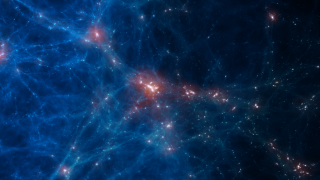Bibcode
Contreras-Santos, A.; Knebe, A.; Cui, W.; Alonso Asensio, I.; Dalla Vecchia, C.; Cañas, R.; Haggar, R.; Mostoghiu Paun, R. A.; Pearce, F. R.; Rasia, E.
Bibliographical reference
Astronomy and Astrophysics
Advertised on:
3
2024
Journal
Citations
13
Refereed citations
8
Description
We characterise the intra-cluster light (ICL) in ensembles of full-physics cluster simulations from THE THREE HUNDRED project, a suite of 324 hydrodynamical resimulations of cluster-sized halos. We identify the ICL as those stellar particles bound to the potential of the cluster itself, but not to any of its substructures, and separate the brightest cluster galaxy (BCG) by means of a fixed 50 kpc aperture. We find the total BCG+ICL mass to be in agreement with state-of-the-art observations of galaxy clusters. The ICL mass fraction of our clusters is between 30 and 50% of the total stellar mass within R500, while the BCG represents around 10%. We further find no trend of the ICL fraction with cluster halo mass, at least not in the range [0.2, 3] 1015 h−1 M⊙ considered here. For the dynamical state, characterised both by theoretical estimators and by the recent merging history of the cluster, there is a clear correlation, such that more relaxed clusters and those that have undergone fewer recent mergers have a higher ICL fraction. Finally, we investigate the possibility of using the ICL to explore the dark matter (DM) component of galaxy clusters. We compute the volumetric density profile for the DM and ICL components and show that, up to R500, the ratio between the two can be described by a power law. Working with the velocity dispersion profiles instead, we show that the ratio can be fit by a straight line. Providing the parameters of these fits, we show how the ICL can be used to infer DM properties.
Related projects

Numerical Astrophysics: Galaxy Formation and Evolution
How galaxies formed and evolved through cosmic time is one of the key questions of modern astronomy and astrophysics. Cosmological time- and length-scales are so large that the evolution of individual galaxies cannot be directly observed. Only through numerical simulations can one follow the emergence of cosmic structures within the current
Claudio
Dalla Vecchia